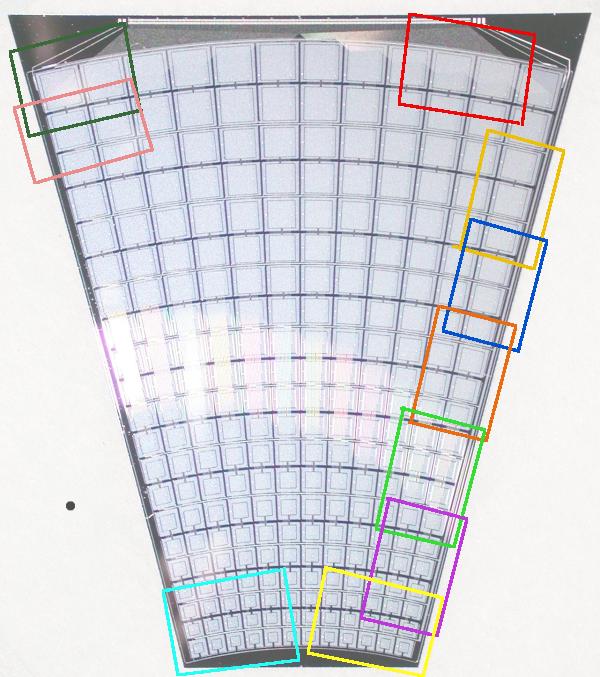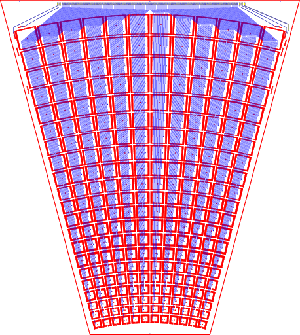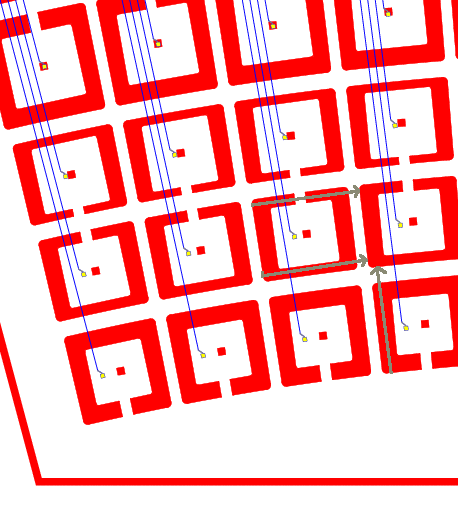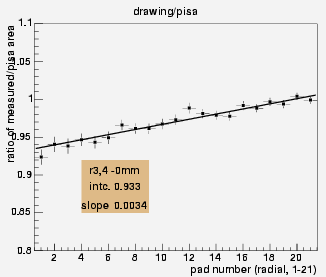
The full pad detector photo is here, and
another one.
The areas marked on the (smaller) photo below show where
I took micrographs. These are in the table below.

In the table below, images correspond to rectangles outlined in the picture above. Click on them to get the full size.
| ||||||||||||||||||||||||||||||||||||||||||||

with an explanation on this page
|
Note that the signals fall off at <70 and >230, where the IR beam is intercepted by the Aluminum readout trace. The area of the dip represents a 1% loss. |

| 
|
|
with an explanation
on this page. Here is
the original postscript file
The ps file is 209095 lines long, and I edited it down to 1930 lines, so
that only 21 pads along the center line are drawn. The boundaries of the pads
in phi are arcs, and along r are straight lines. The corners are rounded.
Thus each pad is made from 42-136 line segments. Here is a link to this
single-row file.
|
|

--------drawing-------- -----software----
pad r1 r2 phi1 phi2 r3 r4 dphir
-------------------------------------------------
1 26.2 46.2 20.4 21.0 5.25 5.45 2.4
2 46.2 66.4 21.4 21.9 5.45 5.65 2.4
3 66.4 86.4 22.3 22.9 5.65 5.85 2.4
4 86.4 111.5 23.2 24.0 5.85 6.10 2.4
5 111.5 136.5 24.2 25.0 6.10 6.35 2.4
6 136.5 161.5 25.3 26.2 6.35 6.60 2.4
7 161.5 191.8 26.6 27.5 6.60 6.90 2.4
8 191.8 221.9 27.9 28.7 6.90 7.20 2.4
9 221.9 252.0 29.0 30.0 7.20 7.50 2.4
10 252.0 282.1 30.4 31.4 7.50 7.80 2.4
11 282.1 312.2 31.8 32.8 7.80 8.10 2.4
12 312.2 342.7 33.1 34.1 8.10 8.40 2.4
13 342.7 377.9 34.5 35.6 8.40 8.75 2.4
14 377.9 413.0 36.0 37.0 8.75 9.10 2.4
15 413.0 447.9 37.6 38.6 9.10 9.45 2.4
16 447.9 483.2 39.0 40.3 9.45 9.80 2.4
17 483.2 523.2 40.7 42.1 9.80 10.20 2.4
18 523.2 563.5 42.4 43.8 10.20 10.60 2.4
19 563.5 603.6 44.1 45.6 10.60 11.00 2.4
20 603.6 649.0 46.0 47.6 11.00 11.45 2.4
21 649.0 694.1 47.9 49.6 11.45 11.90 2.4
------------------------------------------------
Column 1 is the pad number from the inside out. Col 2 is the bottom of the
(red) pad relative to the top of the red boundary line, in mm. Column 3 is
copied from the previous one, shifted by 1.
The next column
is the width of the pad at the inner radius, and the 5th column is the width
at the outer radius. This is the 'active width', from the left side of one
pad to the left side of the next pad.
Note that since the measured numbers are from a x10 drawing, and inner cut line is at 50.0mm from the z-axis, the following relation should hold:
 Using the numbers in the table I plot the ratio of areas. Note that there is a
slope to the ratio. This is due to the fact that the assumed dphi3=2.4°
implies a smaller gap between pads on the inside than on the outside.
Using the numbers in the table I plot the ratio of areas. Note that there is a
slope to the ratio. This is due to the fact that the assumed dphi3=2.4°
implies a smaller gap between pads on the inside than on the outside.
The error bars are now correct, and the total effect is now about 7.5%. |
pad r1 r2 phi_eff ------------------------------- 1 5.252 5.452 2.216038 2 5.452 5.654 2.233846 3 5.654 5.854 2.250410 4 5.854 6.105 2.261362 5 6.105 6.355 2.262403 6 6.355 6.605 2.276802 7 6.605 6.908 2.293868 8 6.908 7.209 2.297191 9 7.209 7.510 2.296660 10 7.510 7.811 2.311130 11 7.811 8.112 2.324506 12 8.112 8.417 2.329408 13 8.417 8.769 2.337040 14 8.769 9.120 2.338082 15 9.120 9.469 2.348670 16 9.469 9.822 2.355274 17 9.822 10.222 2.366840 18 10.222 10.625 2.369118 19 10.625 11.026 2.373764 20 11.026 11.480 2.382871 21 11.480 11.931 2.386204 -------------------------------